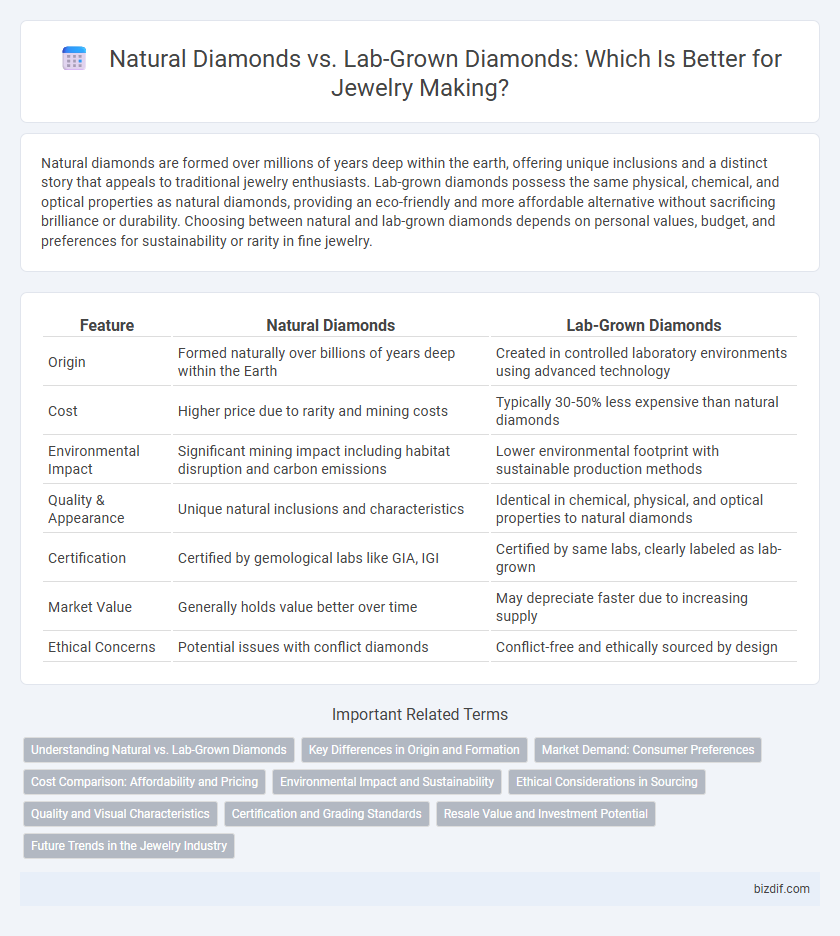Natural diamonds are formed over millions of years deep within the earth, offering unique inclusions and a distinct story that appeals to traditional jewelry enthusiasts. Lab-grown diamonds possess the same physical, chemical, and optical properties as natural diamonds, providing an eco-friendly and more affordable alternative without sacrificing brilliance or durability. Choosing between natural and lab-grown diamonds depends on personal values, budget, and preferences for sustainability or rarity in fine jewelry.
Table of Comparison
| Feature | Natural Diamonds | Lab-Grown Diamonds |
|---|---|---|
| Origin | Formed naturally over billions of years deep within the Earth | Created in controlled laboratory environments using advanced technology |
| Cost | Higher price due to rarity and mining costs | Typically 30-50% less expensive than natural diamonds |
| Environmental Impact | Significant mining impact including habitat disruption and carbon emissions | Lower environmental footprint with sustainable production methods |
| Quality & Appearance | Unique natural inclusions and characteristics | Identical in chemical, physical, and optical properties to natural diamonds |
| Certification | Certified by gemological labs like GIA, IGI | Certified by same labs, clearly labeled as lab-grown |
| Market Value | Generally holds value better over time | May depreciate faster due to increasing supply |
| Ethical Concerns | Potential issues with conflict diamonds | Conflict-free and ethically sourced by design |
Understanding Natural vs. Lab-Grown Diamonds
Natural diamonds form over billions of years through high-pressure, high-temperature conditions deep within the Earth's mantle, resulting in unique molecular structures and inherent rarity. Lab-grown diamonds are created using advanced technological processes such as Chemical Vapor Deposition (CVD) or High Pressure High Temperature (HPHT), producing stones with identical physical, chemical, and optical properties as natural diamonds but typically at a lower cost. Understanding these differences helps jewelers and consumers assess factors like authenticity, value, environmental impact, and ethical considerations when choosing between natural and lab-grown diamonds.
Key Differences in Origin and Formation
Natural diamonds form deep within the Earth's mantle over billions of years through intense heat and pressure, resulting in unique geological characteristics. Lab-grown diamonds are created in controlled laboratory environments using high-pressure high-temperature (HPHT) or chemical vapor deposition (CVD) methods, replicating natural growth processes but within weeks. These differing origins influence their trace elements, inclusions, and environmental impact, distinguishing natural diamonds from synthetic counterparts.
Market Demand: Consumer Preferences
Natural diamonds continue to dominate the luxury jewelry market due to their rarity, historical significance, and perceived value, attracting traditional consumers seeking authenticity. Lab-grown diamonds are gaining significant traction among environmentally conscious buyers and younger demographics who prioritize sustainability and affordability. Market demand increasingly reflects a bifurcation, with natural diamonds preferred for high-end, investment-grade pieces, while lab-grown diamonds capture the casual and ethical consumer segments.
Cost Comparison: Affordability and Pricing
Natural diamonds typically command higher prices due to their rarity and the extensive mining processes involved, often costing up to 40-60% more than lab-grown diamonds of comparable size and quality. Lab-grown diamonds offer a more affordable alternative without compromising on physical characteristics, enabling consumers to purchase larger or higher-quality stones within a more accessible budget. Pricing differences also reflect ethical and environmental considerations, with lab-grown diamonds presenting a cost-effective and sustainable option in the jewelry market.
Environmental Impact and Sustainability
Natural diamonds require extensive mining, which leads to habitat destruction, high energy consumption, and significant carbon emissions, posing challenges to environmental sustainability. Lab-grown diamonds are created using controlled technological processes that consume less energy and produce fewer emissions, making them a more eco-friendly and sustainable option. The reduced environmental footprint of lab-grown diamonds supports ethical jewelry production and aligns better with contemporary demands for green and responsible sourcing.
Ethical Considerations in Sourcing
Natural diamonds often raise concerns regarding ethical sourcing due to issues such as conflict mining, environmental degradation, and labor exploitation. Lab-grown diamonds provide a more sustainable and ethical alternative, as they are produced in controlled environments without the humanitarian and ecological risks associated with traditional diamond mining. Choosing lab-grown diamonds supports responsible practices and transparency in the jewelry supply chain.
Quality and Visual Characteristics
Natural diamonds exhibit unique inclusions and color variations formed over billions of years, contributing to their distinct character and rarity. Lab-grown diamonds possess comparable optical properties, clarity, and hardness, as they are chemically and physically identical to natural diamonds. Both types demonstrate exceptional brilliance and fire, with microscopic differences often detectable only through specialized equipment.
Certification and Grading Standards
Natural diamonds are assessed using established certification bodies like GIA and AGS, which provide detailed grading reports evaluating cut, carat, clarity, and color. Lab-grown diamonds undergo grading by the same institutions, adhering to identical standards, ensuring transparency and trustworthiness in quality assessment. Both diamond types benefit from standardized certification processes that confirm authenticity and value for consumers and jewelers alike.
Resale Value and Investment Potential
Natural diamonds maintain higher resale value due to their rarity and established market demand, often appreciating over time as tangible assets. Lab-grown diamonds, while more affordable and ethically appealing, typically depreciate more quickly and lack the same investment potential because of their manufactured origin. Investors seeking long-term value generally prefer natural diamonds for stronger liquidity and historical price stability.
Future Trends in the Jewelry Industry
Natural diamonds continue to hold value due to their rarity and historical significance, while lab-grown diamonds gain popularity for their ethical sourcing and lower environmental impact. Advances in technology are driving cost reductions in lab-grown diamond production, making them more accessible to younger consumers seeking sustainable alternatives. The jewelry industry is poised to integrate more lab-grown diamonds with cutting-edge certification and customization options, reflecting shifting consumer preferences toward transparency and eco-consciousness.
Natural diamonds vs Lab-grown diamonds Infographic

 bizdif.com
bizdif.com